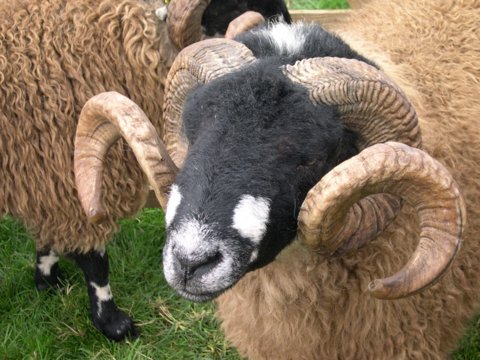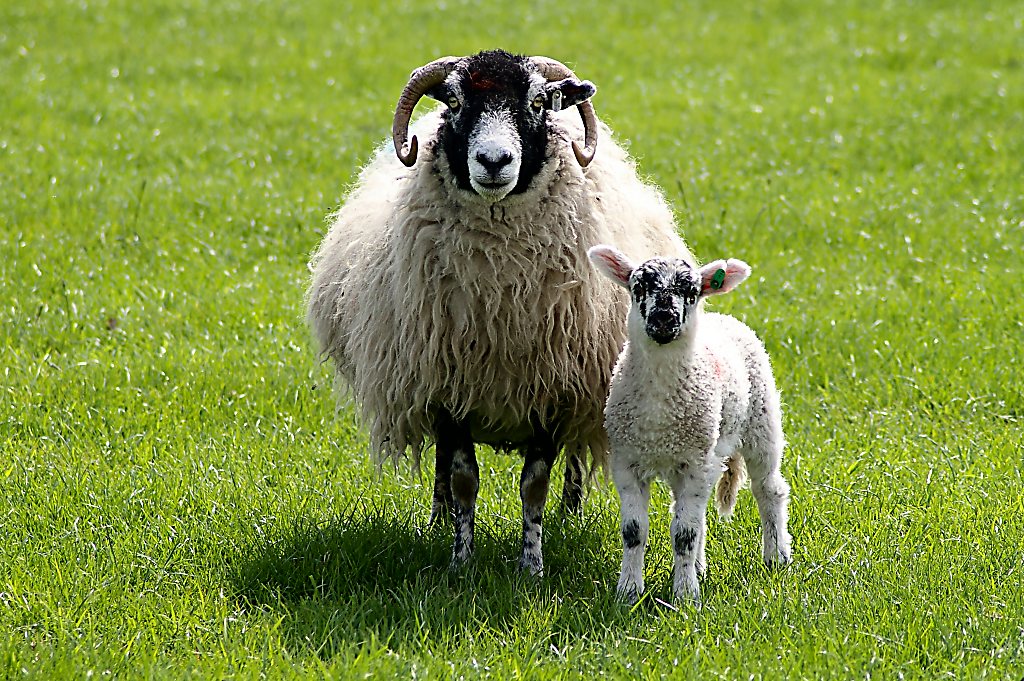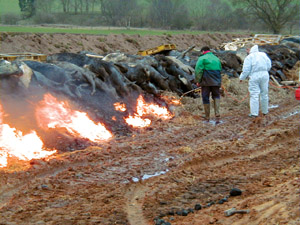|
Dalesbred
The Dalesbred is a breed of domestic sheep originating in England. Derived from the Swaledale and Scottish Blackface breeds, the Dalesbred is a northern hill breed distributed in the Yorkshire Dales and into Lancashire. The Dalesbred is genetically distinct from the other northern hill breeds, the Herdwick and Rough Fell. Very similar in appearance to its parent breeds, both rams and ewes have distinctive horns and a white carpet-quality fleece. Scurs are absent in the breed. It can be best distinguished by having a white spot on each side of its black face, with the end of the muzzle becoming grey. This breed is primarily used for meat and wool production. The legs are free of wool and are mottled black and white. Dalesbred ewes weigh and rams . Dalesbred are a hardy breed capable of surviving the harsh conditions of upland terrain. They are generally bred for several generations in this environment, then ewes are sold to lowland farmers for cross breeding to produce mules. ... [...More Info...] [...Related Items...] OR: [Wikipedia] [Google] [Baidu] [Amazon] |
Swaledale (sheep)
Swaledale is a breed of domestic sheep named after the Yorkshire valley of Swaledale in England. They are found throughout the more mountainous areas of Great Britain, but particularly in the Yorkshire Dales, County Durham, and around the Pennine fells of Cumbria. Swaledales are noted for their off-white wool, curled horns and white around their nose and eyes. They are used for the production of lamb/mutton, the North of England Mule sheep, and as Pedigree breeding stock. Together with the Rough Fell, Herdwick, and Dalesbred sheep, they are one of the four variations associated with the English Lake District. Breed characteristics Well suited to the exposed regions in which they predominantly live, the Swaledales are very hardy, able-bodied, and bold. The ewes make excellent mothers and are known for being able to rear lambs well, even in adverse conditions. They are of a medium build, with black faces marked with bright white around the nose and eyes. Males and females bo ... [...More Info...] [...Related Items...] OR: [Wikipedia] [Google] [Baidu] [Amazon] |
Masham (sheep)
The Masham is a breed of domestic sheep which originated in northern England. It is the progeny of a Teeswater ram and either a Dalesbred or a Swaledale ewe. The ewes are hornless. The breed takes its name from the town of Masham in lower Wensleydale, North Yorkshire North Yorkshire is a Ceremonial counties of England, ceremonial county in Northern England.The Unitary authorities of England, unitary authority areas of City of York, York and North Yorkshire (district), North Yorkshire are in Yorkshire and t .... References External links Mashamat Sheep 101 Sheep breeds originating in England Masham {{sheep-stub ... [...More Info...] [...Related Items...] OR: [Wikipedia] [Google] [Baidu] [Amazon] |
Rough Fell
The Rough Fell is an upland breed of sheep originating in England. It is common on fell and moorland farms, its distribution embracing a large proportion of South Cumbria, parts of the West Riding of Yorkshire, North Lancashire and, more recently, upland parts of Devon. It is very hardy and, as its name suggests, has proved to be well-suited to endure the hardships of exposed and high moorland and mountains. It is one of the largest mountain breeds in Britain. This breed is raised primarily for meat. Characteristics The rough is a dual-purpose commercial breed. Its wool is used for carpet and mattress making and, as it is one of the biggest hill breeds, it is sold for its meat as well. Mature ewes weigh on average and rams As hill sheep roam freely over hundreds of acres of communal grazing on open fell land, their meat is as near to that of a wild animal as one can get in a farmed animal. The hardy constitution of the breed enables a ewe to mother and rear her lambs whil ... [...More Info...] [...Related Items...] OR: [Wikipedia] [Google] [Baidu] [Amazon] |
Sheep With Interesting Horns
Sheep (: sheep) or domestic sheep (''Ovis aries'') are a domesticated, ruminant mammal typically kept as livestock. Although the term ''sheep'' can apply to other species in the genus ''Ovis'', in everyday usage it almost always refers to domesticated sheep. Like all ruminants, sheep are members of the order Artiodactyla, the even-toed ungulates. Numbering a little over one billion, domestic sheep are also the most numerous species of sheep. An adult female is referred to as a ''ewe'' ( ), an intact male as a ''ram'', occasionally a ''tup'', a castrated male as a ''wether'', and a young sheep as a ''lamb''. Sheep are most likely descended from the wild mouflon of Europe and Asia, with Iran being a geographic envelope of the domestication center. One of the earliest animals to be domesticated for agricultural purposes, sheep are raised for fleeces, meat ( lamb, hogget or mutton), and milk. A sheep's wool is the most widely used animal fiber, and is usually harvested by shearing ... [...More Info...] [...Related Items...] OR: [Wikipedia] [Google] [Baidu] [Amazon] |
Highland (geography)
Highlands or uplands are areas of high elevation such as a mountainous region, elevated mountainous plateau or high hills. Generally, ''upland'' refers to a range of hills, typically from up to , while ''highland'' is usually reserved for ranges of low mountains. However, the two terms are interchangeable and also include regions that are transitional between hilly and mountainous terrain. Highlands internationally Probably the best-known area officially or unofficially referred to as ''highlands'' in the Anglosphere is the Scottish Highlands in northern Scotland, the mountainous region north and west of the Highland Boundary Fault. The Highland council area is a local government area in the Scottish Highlands and Britain's largest local government area. Other highland or upland areas reaching 400 m or higher in the United Kingdom include the Southern Uplands in Scotland, the Pennines, North York Moors, Dartmoor and Exmoor in England, and the Cambrian Mountains in Wales. Ma ... [...More Info...] [...Related Items...] OR: [Wikipedia] [Google] [Baidu] [Amazon] |
2001 United Kingdom Foot-and-mouth Crisis
The outbreak of foot-and-mouth disease in the United Kingdom in 2001 caused a crisis in British agriculture and tourism. This epizootic saw 2,000 cases of the disease on farms across most of the British countryside. Over 6 million cows and sheep were slaughtered on farms in an eventually successful attempt to halt the disease. Cumbria was the worst affected area of the country, with 893 cases. With the intention of controlling the spread of the disease, public rights of way across land were closed by order. This damaged the popularity of rural areas such as Wales, Cornwall and the Lake District as tourist destinations and led to the cancellation of that year's Cheltenham Festival, as well as the British Rally Championship for the 2001 season along with the Isle of Man TT, and also delayed that year's general election by a month. Crufts, the international dog show, had to be postponed by 2 months from March to May 2001. By the time that the disease was halted in October 200 ... [...More Info...] [...Related Items...] OR: [Wikipedia] [Google] [Baidu] [Amazon] |
University Of Maryland
The University of Maryland, College Park (University of Maryland, UMD, or simply Maryland) is a public land-grant research university in College Park, Maryland, United States. Founded in 1856, UMD is the flagship institution of the University System of Maryland. It is known as the biggest university in the state of Maryland. UMD is the largest university in Maryland and the Washington metropolitan area. Its eleven schools and colleges offer over 200 degree-granting programs, including 113 undergraduate majors, 107 master's programs, and 83 doctoral programs. UMD's athletic teams are known as the Maryland Terrapins and compete in NCAA Division I as a member of the Big Ten Conference. A member of the Association of American Universities, The University of Maryland's proximity to Washington, D.C. has resulted in many research partnerships with the federal government; faculty receive research funding and institutional support from many agencies, such as the National In ... [...More Info...] [...Related Items...] OR: [Wikipedia] [Google] [Baidu] [Amazon] |
Teeswater (sheep)
The Teeswater is a breed of sheep from Teesdale, England. It is a longwool breed that produces a generally large-diameter fibre. However, the animals are raised primarily for meat. Teeswater sheep have been bred in northern England for about two hundred years; the breed was rare by the 1920s, but has seen a renaissance since World War II. The Rare Breeds Survival Trust has categorised the breed as "at risk". The Teeswater Sheep Breeders' Association was formed in 1949 with the aim to encourage and improve the breeding of Teeswater sheep; to maintain their purity and particularly to establish the supremacy of Teeswater rams for crossing with hill sheep of other breeds for the production of half-bred lambs. Characteristics The wool of the Teeswater should be fine, long-stapled with high lustre with each lock hanging free and with no tendency to felt. There should be no dark fibres in the fleece, which should be uniform in texture over the whole body. The Teeswater produces a kemp ... [...More Info...] [...Related Items...] OR: [Wikipedia] [Google] [Baidu] [Amazon] |
Mule (sheep)
In sheep farming, the term mule is used to refer to a cross between a Bluefaced Leicester ram and a purebred hill (or mountain) ewe (usually a Swaledale sheep) . The production of such mule ewes is a widely used breeding management system which offers several advantages to the farmer. Cross breeding the hill ewe with the lowland ram brings about hybrid vigour or heterosis, which brings the best characteristics of both breeds into one ewe that can be used in producing lamb for the table. The hill ewe, for example the Scottish Blackface, is a hardy animal with good, natural mothering instincts. She is, however, not very prolific and tends to produce one lamb: suited to the harsh conditions. The lowland ram, such as the Blueface Leicester is prolific, producing ewes which give 1-3 lambs and capable of producing enough milk to rear them. The cross between the two, in this case the Scottish mule, has good mothering instincts, good sized lambs and prolific milk production. This mule ... [...More Info...] [...Related Items...] OR: [Wikipedia] [Google] [Baidu] [Amazon] |
Cross Breeding
A crossbreed is an organism with purebred parents of two different breeds, varieties, or populations. A domestic animal of unknown ancestry, where the breed status of only one parent or grandparent is known, may also be called a crossbreed though the term "mixed breed" is technically more accurate. Outcrossing is a type of crossbreeding used within a purebred breed to increase the genetic diversity within the breed, particularly when there is a need to avoid inbreeding. In animal breeding, ''crossbreeds'' are crosses within a single species, while '' hybrids'' are crosses between different species. In plant breeding terminology, the term ''crossbreed'' is uncommon, and no universal term is used to distinguish hybridization or crossing within a population from those between populations, or even those between species. Crossbreeding is the process of breeding such an organism. It can be beneficially used to maintain health and viability of organisms. However, irresponsible crossbre ... [...More Info...] [...Related Items...] OR: [Wikipedia] [Google] [Baidu] [Amazon] |
Lowland
Upland and lowland are conditional descriptions of a plain based on elevation above sea level. In studies of the ecology of freshwater rivers, habitats are classified as upland or lowland. Definitions Upland and lowland are portions of a plain that are conditionally categorized by their elevation above the sea level. Lowlands are usually no higher than , while uplands are somewhere around to . On unusual occasions, certain lowlands such as the Caspian Depression lie below sea level. Uplands areas tend to spike into valleys and mountains, forming mountain ranges while lowland areas tend to be uniformly flat, although both can vary such as the Mongolian Plateau. Upland habitats are cold, clear and rocky whose rivers are fast-flowing in mountainous areas; lowland habitats are warm with slow-flowing rivers found in relatively flat lowland areas, with water that is frequently colored by sediment and organic matter. These classifications overlap with the geological definitions ... [...More Info...] [...Related Items...] OR: [Wikipedia] [Google] [Baidu] [Amazon] |
Lamb And Mutton
Lamb and mutton, collectively sheep meat (or sheepmeat) is one of the most common meats around the world, taken from the domestic sheep, ''Ovis aries'', and generally divided into lamb, from sheep in their first year, hogget, from sheep in their second, and mutton, from older sheep. Generally, "hogget" and "sheep meat" aren't used by consumers outside Norway, New Zealand, South Africa, Scotland, and Australia. Hogget has become more common in England, particularly in the North (Lancashire and Yorkshire) often in association with rare breed and organic farming. In South Asian and Caribbean cuisine, "mutton" often means goat meat.''Oxford English Dictionary'', 3rd edition, June 2003Italian, make similar or even more detailed distinctions among sheep meats by age and sometimes by sex and diet—for example, ''lechazo'' in Spanish refers to meat from milk-fed (unweaned) lambs. Classifications and nomenclature The definitions for lamb, hogget and mutton vary considerably between ... [...More Info...] [...Related Items...] OR: [Wikipedia] [Google] [Baidu] [Amazon] |








